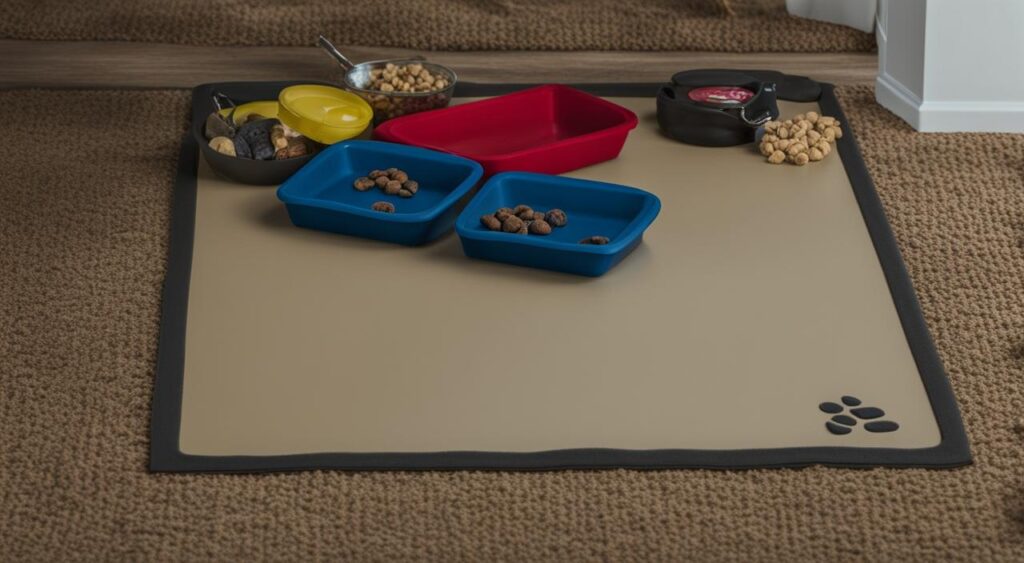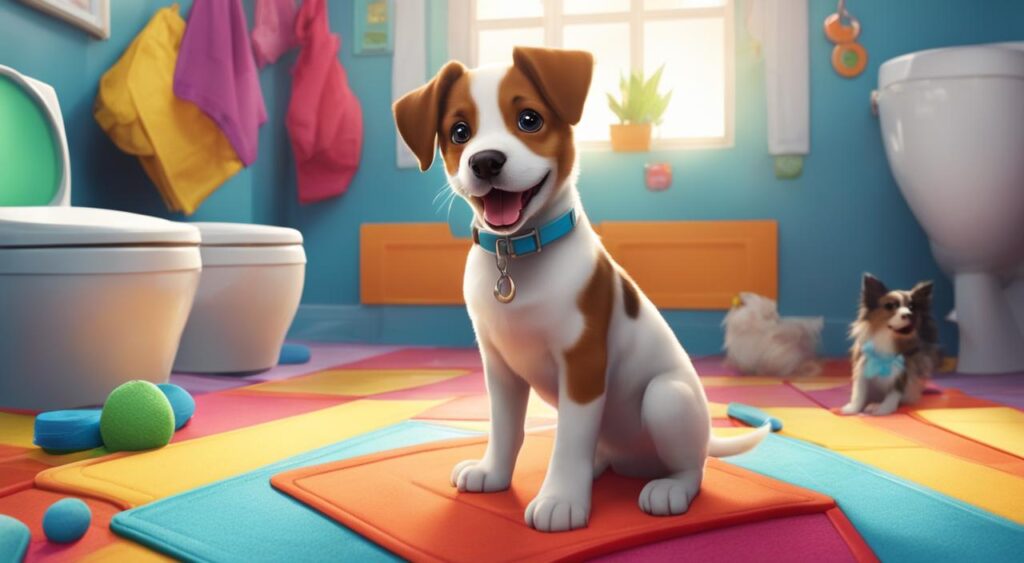Teaching your furry friend to use a potty training pad can save you time and effort, while ensuring your home stays clean and hygienic. It can also be an effective solution for pet owners who live in apartments or houses without a backyard. In this guide, we’ll provide you with expert tips and tricks to successfully train your dog to use a potty training pad.
Key Takeaways:
- Training your dog to use a potty training pad can be a convenient and practical solution, especially for apartment dwellers.
- Choosing the right location and setting up the pad correctly can help encourage your dog to use it.
- Establishing a consistent routine and using positive reinforcement are key to successful potty training.
- Common challenges may arise during the training process, but it’s important to remain patient and consistent.
- Successfully training your dog to use a potty training pad can improve your relationship with your pet and create a cleaner and more pleasant home environment.
Why use a toilet mat
Teaching your dog to use the toilet mat has many advantages. The first of them is practicality. When using the mat, you don’t need to leave the house or clean other areas of the floor, as the mat is a single place for your dog to do his business.
Furthermore, using a hygienic mat keeps the house clean and prevents unpleasant odors. Hygiene mats are designed to absorb your dog’s urine, preventing it from getting on the floor or other places in the house.
Using the training mat also makes the task of teaching your dog to do his business in a specific place easier and faster. Over time, your dog will learn to associate the toilet mat with the area where he needs to eliminate.
Advantages of using a toilet mat
| Advantages of the toilet mat | Disadvantages of not using a toilet mat |
|---|---|
| Prevents dirt around the house | Frequent cleaning of urine and feces in different parts of the house |
| No need to leave the house several times a day | Spending time and money to walk the animal |
| Suitable for dogs living in apartments | Out of the owner’s control when dog needs to go to the bathroom |
| Reduction of unwanted odors | Dogs can eliminate in inappropriate areas of the house, damaging furniture, objects and floors. |
“Training your dog to use the toilet mat not only makes his routine easier, but also keeps the house clean and smelling good. Furthermore, the animal learns to have a specific place to do his business and this helps with obedience training.” -Kevin Richardson
Try using the toilet mat as a training tool for your dog. The benefits are countless, and the comfort and practicality will be good for you and your best friend.
Preparing the environment
Before introducing your dog to a potty training pad, it’s important to prepare the environment to make the training process easier. Here are some tips to help:
Choose the right location
Find a quiet and easily accessible area in your home where your dog can comfortably use the potty pad. A bathroom, laundry room, or any area with easy-to-clean flooring is a great choice. Avoid high-traffic areas or rooms where your dog may feel uncomfortable or distracted.
Set up the potty pad
Place the potty pad in the chosen location. Make sure it is secure and won’t move around while your dog is using it. If you’re using a disposable pad, consider putting a plastic sheet underneath to protect your floors.
“By following these simple steps, you can create a comfortable and inviting space for your dog to use the potty pad.”
Add a cue
Introduce a verbal cue such as “go potty” or “go pee” to help your dog associate the action with the potty pad. Repeat the cue every time your dog uses the pad to reinforce the behavior.
Reward good behavior
Whenever your dog uses the potty pad, reward them with praise and treats to encourage them to continue using it. Positive reinforcement is key to successful potty training.
Introducing Your Dog to the Potty Pad
Introducing a new element to your dog’s routine can be tricky, but with some patience and the right approach, you can successfully train them to use a potty training pad.
The first step is to choose the right location for the pad. Place it in an area that is easily accessible and away from your dog’s food and water bowls. Make sure the pad is secure and won’t move around as your dog uses it.
To encourage your dog to use the pad, you can start by placing them on it after waking up, before and after meals, and after playtime. By doing this consistently, your dog will begin to associate the pad with relieving themselves.
You can also use treats and positive reinforcement to make the pad appealing to your dog. Use a high-value treat and praise your dog when they use the pad correctly.
Remember to avoid scolding or punishing your dog if they have accidents or don’t use the pad right away. This can discourage them from using the pad in the future.
By following these tips, you can successfully introduce your dog to the potty training pad and start the training process on the right foot.

Creating a training routine
A consistent routine is key to successful potty training. Follow these step-by-step instructions to train your dog to use the potty pad:
- Start by placing the potty pad in an easily accessible location, away from your dog’s sleeping and eating areas.
- Take your dog to the pad after waking up, eating or drinking, and playing, as these are the times when they are most likely to need to go.
- Verbally encourage your dog to use the pad, using a command like “go potty.”
- When your dog successfully uses the pad, give them verbal praise and a treat as a reward.
- If your dog has an accident, clean it up immediately without scolding them, and try again later.
- Stick to a consistent schedule, gradually increasing the time between potty breaks as your dog becomes more accustomed to using the pad.
Remember to be patient and consistent throughout the training process, as it may take some time for your dog to learn to use the potty pad effectively.
Pro tip: If your dog is having trouble using the pad, try placing some of their waste on the pad as a scent cue. This may make it more appealing and encourage them to use it.
“Consistency is key when it comes to potty training. Stick to a schedule and be patient – your furry friend will get the hang of it eventually!”
Reinforcing Good Behavior
During the potty training process, positive reinforcement is key to teaching your dog to use the potty pad consistently. Dogs respond well to rewards and praise for good behavior, so it’s important to reinforce their use of the potty pad every time they use it.
One effective technique is to give your dog a small treat immediately after they successfully use the potty pad. This will reinforce the behavior and encourage them to use the pad in the future. Verbal praise and affection can also be effective, as many dogs thrive on positive attention from their owners.
It’s important to reinforce good behavior consistently and immediately, so your dog associates going potty on the pad with positive experiences. Avoid punishment or scolding for accidents, as this can discourage your dog and make potty training more difficult.
Consistency is key when reinforcing good behavior. Make sure everyone in your household is on the same page when it comes to reinforcing the use of the potty pad, and try to keep your dog’s routine as consistent as possible to help them learn quickly.
Dica: If your dog is having trouble using the potty pad consistently, try changing up the type of treats you use for positive reinforcement. Some dogs may be more motivated by certain types of treats or toys, so it’s important to find what works best for your pup.
Problems with Potty Training
While teaching your dog to use a potty training pad is beneficial, there may be some common problems during the process.
One issue may be that your dog ignores the potty pad and relieves themselves elsewhere. In this case, try placing the potty pad in a more desirable location or try a new brand of the pad.
Another common problem is accidents on the floor. If this happens, clean the site thoroughly to eliminate the scent and avoid future accidents.
If your dog shows resistance to using the potty pad and refuses to relieve themselves on it, try incentivizing them with treats or spending more time with them in the designated area.
Remember, potty training takes patience and persistence. Consistently encouraging your dog to use the potty pad and rewarding good behavior will ultimately lead to success.
Pro tip: If problems persist, consult with a professional dog trainer for additional guidance and support.
Patience and consistency
Teaching your dog to use a toilet mat can be challenging, but patience and consistency are crucial to success. It is important to establish a clear training routine and follow the tips mentioned in the previous sections.
It is natural for there to be setbacks during the training process, such as accidents or resistance on the part of the dog. However, it is essential to remain positive and continue following the established routine.
By showing patience and consistency, you are teaching your dog to use the toilet mat effectively and in the long term. Remember that each dog is unique in their training needs, so adapt your method according to what works best for your pet.
Some dogs may learn more quickly than others, but all will require time and dedication. With persistence, you and your dog can master potty mat training and enjoy a clean, pleasant environment at home.
Alternatives to toilet mat
Although the toilet mat is a great option for teaching your dog to eliminate in the right place, there are other alternatives you can try. Below we list some:
Newspaper
Newspaper is a common substitute for toilet mat. However, keep in mind that it can be less durable and absorbent than carpet, which can result in leaks and greater cleaning difficulties.
Sandbox
For cat owners, the litter box can be a great alternative to a toilet mat. However, it may not be the best option for a dog, as they may be less likely to use a crate and more likely to dig and spread litter around the house.
Dog house with removable bars
Some people prefer to teach their dogs to eliminate in a specific area of the house, such as a dog house with removable fences. This may work well for dogs who are already used to a crate, but may be more difficult for dogs who are still in the training process.
| Alternative | Pros | Contras |
|---|---|---|
| Newspaper | Economic | Less durable and absorbent, difficult to clean |
| Sandbox | Good for cats | Dogs can dig and spread sand around the house |
| Dog house with removable bars | May work well for dogs accustomed to a crate | Can be difficult for dogs in the training process |
It is important to remember that not all alternatives will work for all dogs. What works for one may not work for another. However, trying out a few different options can help you find the best choice for your pet.
Maintaining long-term success
After successfully training your dog to use a potty training pad, it’s important to maintain their good habits in the long run. Consistency is key. Keep the potty pad in the same place, and reward good behavior every time. Regularly reinforce the behavior to ensure it becomes a habit. Adapt the training as your dog grows and their needs change.
Make sure to keep the potty pad clean and replace it regularly. If you notice your dog having accidents, don’t give up. Instead, try to identify the root cause and address it through positive reinforcement and consistent training.
It’s also worth monitoring your dog’s behavior to identify any health issues that may be affecting their toilet habits. Consult your veterinarian if you notice any changes in your dog’s potty behavior, such as frequent accidents or difficulty using the potty pad.
Tips for Maintaining Potty Training Success
- Be consistent in your training methods and expectations
- Continue positive reinforcement with treats and praise
- Keep the potty pad in the same location
- Regularly reinforce the behavior to make it a habit
- Adapt the training as your dog grows and their needs change
- Keep the potty pad clean and replace it regularly
- Monitor your dog’s behavior for any health issues

Rewards Beyond Training
In addition to creating a clean and organized environment, teaching your dog to use the toilet mat can bring many additional rewards. One of the main advantages is improving the relationship between you and your furry friend.
When your dog learns to use the toilet mat, both of you can enjoy a more harmonious and pleasant coexistence at home. You won’t have to clean up nasty accidents on the floor, and your dog will be comfortable and happy using his new designated space for his daily needs.
Additionally, training to use the toilet mat can help keep your dog’s health up to date. This is because you can observe the frequency of bathroom visits and ensure that he is relieving himself regularly. Health problems such as constipation can be avoided by carefully monitoring your training routine.
Overall, teaching your dog to use the toilet mat is an investment that brings many benefits to both of you. Take the opportunity to create a peaceful and healthy coexistence with your pet.
Conclusion
Teaching your dog to use a potty training pad may take some time and effort, but the benefits are worth it. With a designated area for your dog to relieve themselves, you can enjoy a cleaner home and a closer relationship with your furry friend.
Remember, the key to success is patience, consistency, and positive reinforcement. Follow the steps and tips outlined in this guide, and don’t be discouraged by setbacks or accidents along the way. With a little persistence, you can successfully teach your dog to use a potty training pad.
And if you do encounter any issues, don’t hesitate to refer back to the troubleshooting section of this guide. With the right tools and techniques, you can overcome any challenge and achieve long-term success.
Thank you for taking the time to read this guide, and we wish you and your dog all the best in your potty training journey!
FAQ
How do I teach my dog to use the toilet mat?
To teach your dog to use the toilet mat , start by introducing the mat into the designated area. Take your dog to the mat after meals, playtime and when he wakes up. Use verbal commands and rewards to encourage mat use. Remember to be patient and consistent throughout the process.
Why should I use a toilet mat for my dog?
Using a toilet mat facilitates the process of training your dog to eliminate in a specific place. The mat provides a delimited and hygienic area, preventing your dog from peeing or pooping in unwanted places inside the house. Plus, it’s easy to clean and offers convenience for both you and your dog.
How should I prepare the environment for training with the toilet mat?
Choose a quiet and accessible place to place the toilet mat. Make sure it’s an area that’s easy to clean and away from valuables. Place the mat in a fixed location and always offer rewards to your dog when he uses the mat correctly.
What is the best way to introduce my dog to the toilet mat?
To introduce the toilet mat to your dog, place it in a specific area and teach your dog to become familiar with the smell and texture of the mat. Let him explore and reward him with treats or praise when he shows interest or uses the mat correctly.
How should I establish a training routine with the toilet mat?
Establishing a training routine with the toilet mat is essential. Take your dog to the mat at regular times, such as right after meals, after waking up and before bed. Use verbal commands such as “pee” or “poop” to teach your dog what is expected of him. Praise and offer rewards when he uses the mat correctly.
How to reinforce good behavior during training?
Reinforcing good behavior during training with the toilet mat is essential. Praise, pet and offer rewards to your dog whenever he uses the mat correctly. Use treats or toys as a reward to encourage him to continue relieving himself in the right place.
What common problems can arise during toilet mat training?
During toilet mat training, it is common to face some problems, such as the dog not wanting to use the mat, doing its business in the wrong place or having accidents outside the mat. For each problem, there are specific solutions, such as reevaluating the location of the mat, reinforcing routine and patience, or seeking help from a professional dog trainer.
How important is patience and consistency during training?
Patience and consistency are essential during toilet mat training. Each dog learns at its own pace, so it’s important to be patient and not give up. Additionally, being consistent with the routine, verbal commands and rewards will help your dog understand what is expected of him and adapt to using the toilet mat.
Are there alternatives to using a toilet mat?
Yes, there are alternatives to using toilet mats, such as dog litter boxes or synthetic grass. Each alternative has its advantages and disadvantages, and the choice depends on your dog’s needs and the conditions of the environment in which he lives. Research and evaluate which option is best suited to your case.
How can I maintain long-term training success?
To maintain the success of potty mat training in the long term, it is important to continue following the established routine, reinforcing your dog’s good behavior and adapting the training as he grows. Additionally, avoid punishment and maintain a positive attitude throughout the process.
What are the rewards beyond training that I can get from using the toilet mat?
In addition to facilitating the training process, the use of a toilet mat offers benefits such as a cleaner and more hygienic environment, better coexistence at home and a reduction in stress and frustration caused by accidents. Additionally, training your dog to use the mat strengthens the bond between you and promotes a healthier, happier relationship.




